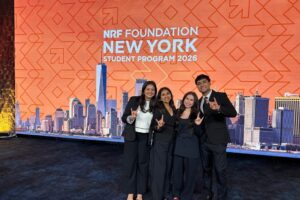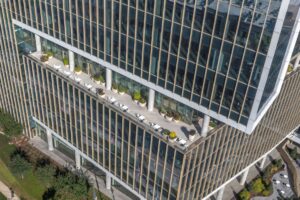Dr. Jeffrey Bennighof is an aerospace engineering and engineering mechanics professor. This article first appeared on the Department of Aerospace Engineering and Engineering Mechanics Web site.
You may have noticed that noise levels in cars have been decreasing over the years. One reason is that car manufacturers around the world have been using vibration analysis software written here in the Department of Aerospace Engineering and Engineering Mechanics.
The software uses an approach that has roots in our department dating from the 1960s. Professor Roy Craig, who retired in 2001, played a key role in developing the “component mode synthesis” (CMS) method. In CMS, a finite element model of an airplane, for example, is divided into several substructures (wings, fuselage, empennage, etc.) so that models of substructures can be reduced before assembling them together to form a more manageable model of the overall structure. Our software implements “automated multilevel substructuring” (AMLS), which takes the CMS approach to an seemingly ridiculous extreme.
In AMLS, a finite element model of a car with about 10 million degrees of freedom is divided into substructures, and substructures of substructures, and so on, until the model has been divided into tens of thousands of substructures on dozens of levels. Models of individual substructures are reduced greatly to produce a model of the overall structure that has about 1/100 as many degrees of freedom as the model had originally. Then this reduced model is used to approximate about 10,000 natural frequencies and modes of the structure, so that vibration can be analyzed efficiently. In CMS, model reduction is done manually, but in AMLS, the substructuring process is entirely automated. The trick is to do it very efficiently and without losing accuracy.

Using AMLS for vibration analysis in cars had its beginnings in a research project focused on submarines. In the 1990s, the department was funded by the Navy to develop a substructuring method for predicting submarine vibrations. Submarine funding decreased after the end of the Cold War, but we began to see how a new method, which turned out to be AMLS, might work to handle very large vibration problems. At about this time the auto industry began creating fairly detailed models of entire cars so that they could be analyzed and made quieter while they were still “on the drawing board.”
Using the most efficient solver algorithm available at the time, car companies required extremely expensive liquid-cooled Cray supercomputers for vibration analysis. Ford Motor Co., for example, was spending over $10 million per year on computer time to analyze vibrations. To explore future capabilities, Ford created a reasonably detailed model of a car body but found that their fastest computer took four weekends, when it was not carrying its normal workload, to get the results they wanted. When a manager at Ford learned that we might have a faster way to solve their problem, he arranged to get us access to their supercomputers. We were able to run their four-weekend problem in a few hours on a Tuesday afternoon when their machines were busy with their normal job queues.
That got them interested, and they began to fund us for a few years to get our “research code” ready for production use. They also encouraged us to make the code available to other car companies, because they had learned that if a code became standard across the industry it was likely to be of better quality than if Ford had exclusive rights to it.
We developed AMLS for as broad a market as possible. We began working with a German-based firm that provides world-class consulting to the car industry, and started using them as our distribution channel. A number of auto companies in the United States, Europe and Japan quickly adopted AMLS soon after, when it became commercially available in 2001. The number of licensees has continued to increase, and now most carmakers worldwide have become AMLS users.



